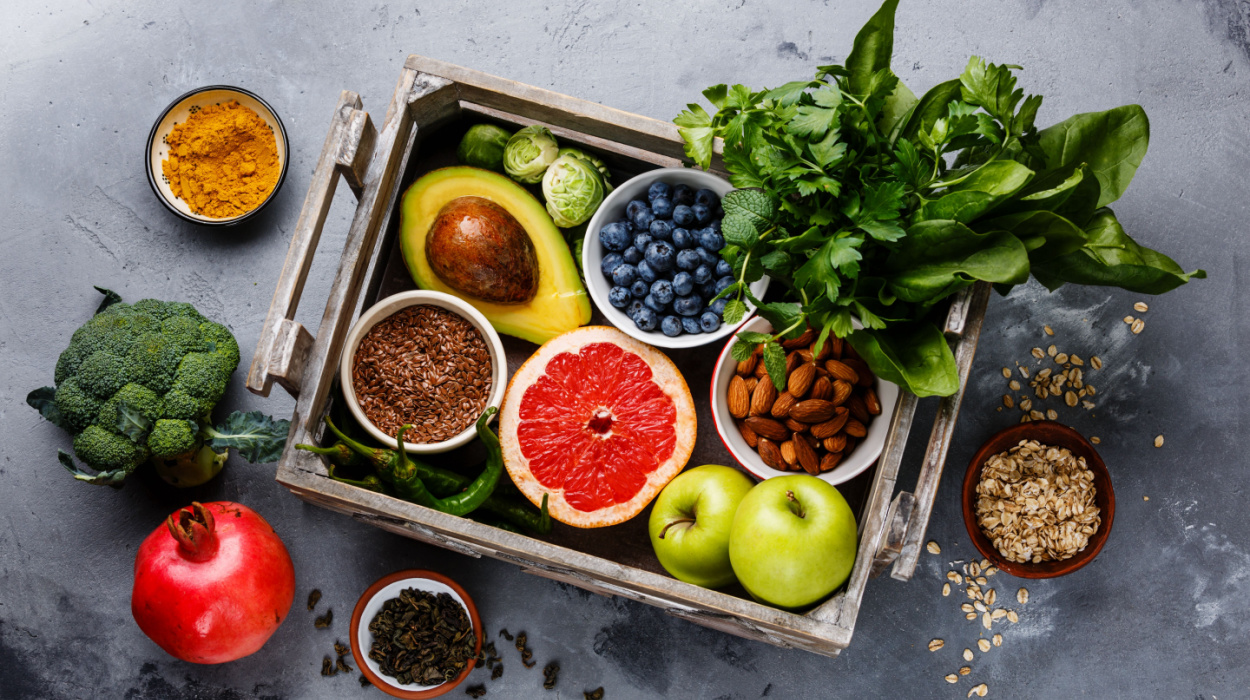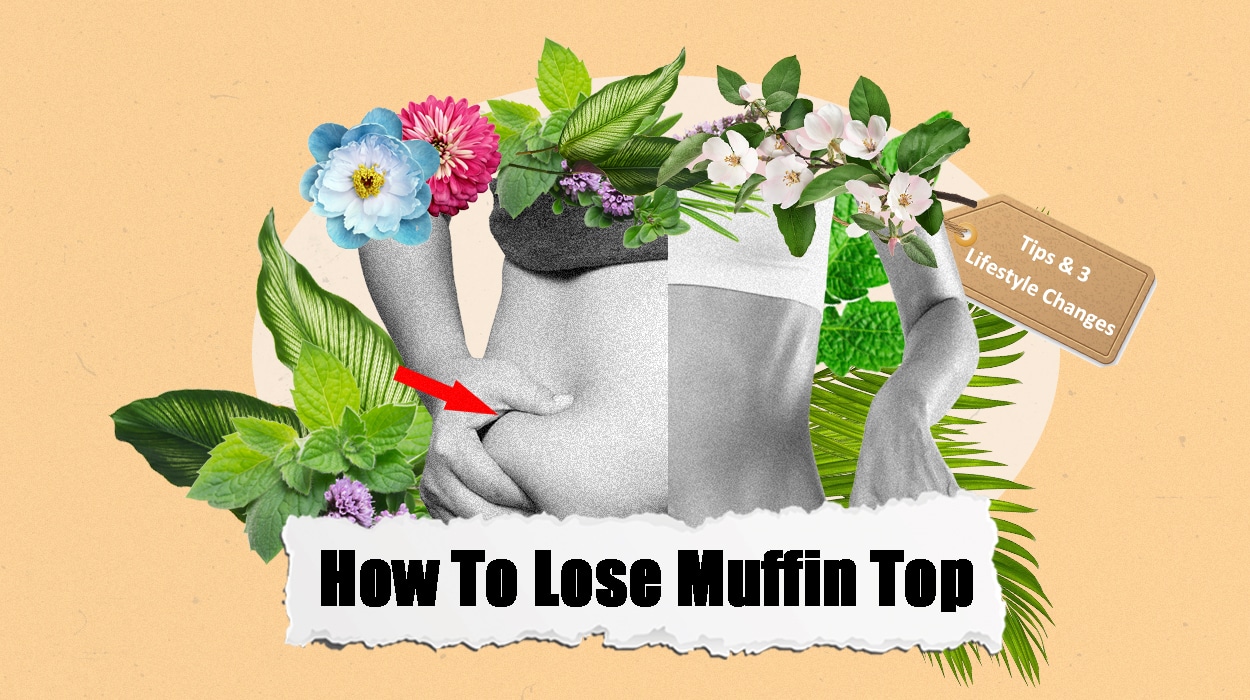The “muffin top” is another term for lower back fat. Within this article, we will cover 3 lifestyle changes that can help get rid of your “muffin top”.
We then go on to explore the cause of belly fat gain 3 variables that influence it, and whether they can be modified to burn excess body fat fast.
Ways To Get Rid Of Your “Muffin Top” – 3 Lifestyles Changes
1. Diet
- Eat the majority of “healthy” food
- Limit “unhealthy” food
- Limit snacking and grazing
- Estimate caloric requirements and track food intake, if possible
- Thermic effect of food: protein and fiber have high thermogenic effects.
2. Exercise
- Cardio Exercise (Aerobic)
- Resistance Training
3. Non-Exercise Activity-induced Thermogenesis (NEAT)
- Chewing low-calorie gum
- Washing the dishes
- Mowing the lawn
- Hand washing your car
- Doing the laundry
- Cleaning and hoovering the house
- Use a step tracker (mobile app or watch) and be conscious about your activity level
- Taking the stairs instead of the elevator
- Walking to your destination if possible
- Parking further away from your destination to promote more walking
- Repetitively squeezing a stress ball
3 Lifestyle Changes To Get Rid Of Your “Muffin Top”
Diet

Total Caloric Intake
It is possible to control daily calories through food choice and quantity.
All foods consist of the three macronutrients/calories[1] which I have listed below:
- Protein (4 kcal/1g)
- Carbohydrates (4 kcal/1g)
- Fat (9 kcal/1g)
Alcohol has its own calorie composition of 7 kcal/g. For more information, feel free to refer to my other article “Does Alcohol Stop Fat Burning: Truth and Healthy Advice 2022”.
For this reason, indulging in food and alcohol can promote stubborn belly fat deposits, weight loss, and the dreaded “Muffin Tops”. Some food choices are lower in calories, and higher in micronutrients, and dietary fiber.
Hence, why they are considered “healthy” and satiating, allowing you to eat fewer calories, yet feel full enough not to overeat to take in excess calories. An example of a “healthy” food choice could be grilled chicken breast and broccoli (220 kcal).
On the other hand, some food selections have a higher number of calories and are not as nutrient-dense from being saturated with fatty oils and cheeses. An example of “unhealthy” food could be 2 pieces of fried chicken and fries (855 kcal). These foods are easy to overeat and not very filling, they should be limited. Snacking and grazing are also worth limiting, as their calories are notorious for adding up without realizing it.
4 key take-home points for excess abdominal fat loss to help keep those “muffin tops” at bay include:
- Eat the majority of “healthy” food
- Limit “unhealthy” food
- Limit snacking and grazing
- Estimate caloric requirements and track food intake if possible
Thermic Effect Of Food
It may come as a surprise that digesting and processing food actually burns calories.
The most thermogenic nutrients are protein and fiber, burning a 20-30%[2] equivalent of their own calories. Carbohydrates have a lower TEF of around 5-10%, and fat with the lowest of 3%[2]
TEF can be modified in order to burn more calories by adjusting the ratio of macronutrient consumption if needed.
This process only accounts for around 10% of total daily energy output.[2] All in all, to take advantage of TEF, try not to observe a diet with a higher ratio of dietary fat. That’s not to say you should neglect dietary fat, as it plays a vital role in hormones and health.[2]
Exercise
Cardio Exercise (Aerobic)

The current guideline suggests 150-300 minutes of moderate-intensity aerobic exercise per week.[3]
Generally, we are looking at 3-4 cardiovascular sessions at anywhere from 60-75% of maximum heart rate, depending on your capability. You can also opt for high-intensity interval training, which is a bit more strenuous and advanced. Such an intervention can “burn” over 500 calories per session, which may help with reducing belly fat and drawback that unwanted “muffin top”.
My 8 “go to” cardiovascular exercises to get rid of a muffin top and help with losing weight include:
- Treadmill running
- Cycling
- Rowing
- Cross trainer
- Burpees
- Knees Bent Bird dog
- Brisk walking
- High-intensity sprints in a straight line
Resistance Training
It is well apparent that cardiovascular exercise can improve heart and lung functions, as well as acutely burn calories. However, from my observation, resistance training is often avoided, from an irrational fear of becoming too muscular, especially among women. Huge mistake, because muscle is one of the more energy-taxing bodily tissues, expending on average 6 kcal/lb.
A minimum of 1-2 whole body-resistance[3] sessions per week is recommended. Each session could include 8-10 exercises, 2-3 sets per exercise, and 8-12+ reps per set. In the long term, resistance training could develop some strength, and muscle tone and boost the metabolic rate. In the longer term, this intervention could help burn fat.
My 8 “go to” of resistance training exercises include:
- Bench press
- Barbell squat
- Bent-over barbell row
- Lat pulldown
- Leg Press
- Deadline
- Dumbbell shoulder press
- Hammer strength chest press
NEAT
Non-Exercise Activity-induced Thermogenesis, abbreviated as “NEAT”, are calories “burnt” through the conscious and subconscious movements that are not directly exercised. We all know that one person cannot sit still. Usually quite slim and does not hold ‘muffin tops’ right?
There is a direct link between leaner individuals and “high” NEAT levels, who could “burn” an extra 2000 calories per day.[4]
This level of caloric output is almost double compared to their overweight and obese counterparts, who inherently tend to be more sedentary in their time, engaging in activities like lying down and watching the television[4] thus building up the “muffin top”. If you believe you are not a naturally active person, all is not lost as NEAT is extremely modifiable from conscious effort too.
11 examples of NEAT that you could utilize, include:
- Chewing low-calorie gum
- Washing the dishes
- Mowing the lawn
- Hand washing your car
- Doing the laundry
- Cleaning and hoovering the house
- Use a step tracker (mobile app or watch) and be conscious about your activity level
- Taking the stairs instead of the elevator
- Walking to your destination if possible
- Parking further away from your destination to promote more walking
- Repetitively squeezing a stress ball
What Causes Muffin Top And Visceral Fat?
Do you ever recall sitting on the seesaw in the park and being lifted straight off the ground by the chubby kid on the opposite side?
I DO!
I was the chubby kid, nostalgic at the least, or Google image search “seesaw” if you are from Generation Z or above.
On a serious note, like a “seesaw”, if energy input (calories in from food) exceeds energy output (calories out from activity), you would expect to gain some excess belly fat. This is known as a caloric surplus where your body is forced to store additional calories within fat cells as a survival mechanism for a reserve of energy, known as lipogenesis, to be utilized during periods of famine.[5]
Famine?
Surely, it is an undesirable and unneeded survival mechanism as we have a bolus of food available at our fingertips? But, intuitively, it only makes perfect sense if we look back millions of years at our ancestors who would most probably be hunting and overfeeding, followed by harsher periods of being deprived of food.[5]
Now, can you imagine not having that precious store of energy/body fat? The real Fred Flintstone would be extinct from not having a good hunting session, and you would not be here looking for ways to lose the “muffin top”
So What Does This Have To Do With “Muffin Top” Fat?
A consistent caloric surplus will cause fat stores to build up in random places.[6] And one of these sites is the hips, inevitably piling up and forming that muffin top shape. Some individuals are more susceptible to storing fat around the hips, as you will come to learn.
The 3 Varieties That Influence Muffin Top And Can They Be Modified To Get Rid Of It?
Lifestyle
Many lifestyle interventions could be put in place to drive a caloric deficit and reduce body fat,[6] subsequently keeping the “muffin top” under control.
As we will cover, the main components of lifestyle include:
- Diet
- Exercise
- Nonexercise activity-induced thermogenesis (NEAT)
Genetics/Ethnicity
Genetics/ethnicity determines the amount of fat we accumulate around the hips. For example, the adipocyte (fat cell) composition around the hips of East-Asian women is much less, compared to African and Hispanic women.[7] We can support this with research[7] and anecdotes. Genetics/Ethnicity is NOT modifiable. So as the saying goes, “We cannot change the cards we are dealt” – Randy Pausch.
Gender
Women are more likely to develop a “pear-shaped/muffin top” body fat disposition[8] compared to their male counterparts. This is mainly due to the composition of sex hormones[8] and “evolutionary” gender roles i.e. hunting and birth-giving.
Conclusion
The “muffin top” can become apparent after significant belly fat gain. Females and people with specific genetics are more likely to deposit more belly fat around the hips, forming the “muffin top”. To lose belly fat and lose weight, we must promote a caloric deficit through diet, exercise, and activity levels. Unfortunately, there are no “proven” exercises or interventions that can spot and reduce belly fat around the hips, or else I would have highlighted them.
Frequently Asked Questions
It is not possible to reduce belly fat. When you observe a healthy diet (calorie-controlled) and a regular exercise routine, you can lose weight and reduce excess fat.
Unfortunately yes! If you are genetically predisposed to the muffin top you may still have it while being lean with a flat stomach.
 Expert's opinion
Expert's opinion
